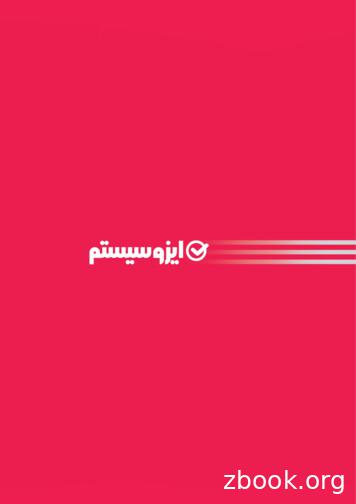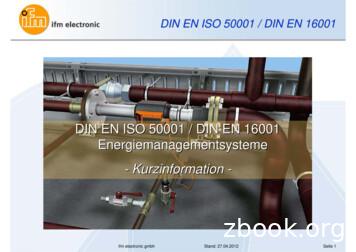ISO 50001:2018 Transition Policy Document
ISO 50001:2018Transition Policy Document(For external use)Policy Document for Migration to ISO 50001:2018
INTRODUCTIONISO 50001:2018 was released on 21st August 2018 and is replacing the existing Energy ManagementSystem ISO 50001:2011.Certification Europe is accredited to certify organisations to ISO50001:2011 and intends to be in a positionto offer accredited ISO50001:2018 certifications by 21st February 2019. As per the requirements of IAFResolution 2017-14, Certification Europe will cease conducting audits including initial, surveillance andrecertification to ISO 50001:2011 18 months after the release of ISO 50001:2018, i.e. 21st February 2020.Existing clients who have ISO 50001:2011 will be required to migrate their Energy Management Systemwithin 30 months of the date of publication of ISO 50001:2018. All transition audits must therefore becompleted by 21st February 2021.The following table summarises the certification that will be offered by Certification Europe during thetransition period: (pending accreditation of CE by INAB to ISO50001:2018 by 21st February 2019)DatesUntil 21st February 201921st February 2019 to 21st February 2020From 21st February 2020Standard OfferedISO50001:2011 onlyISO50001:2011 OR ISO50001:2018ISO50001:2018 onlyExisting ISO 50001:2011 certifications will no longer be valid after 21st of August 2021 and any ISO50001:2011 certificates issued by Certification Europe during this period will expire on the 21st of August2021.Once clients successfully migrate their existing ISO 50001 system the expiry date of their ISO 50001:2018certificate will be in-line with their current three-year certification, so no certification time will be lost.Certification Europe has created this policy document to clarify the certification process for current andfuture clients.Date: 2019-02-14Page 1 of 6
KEY CHANGES IN ISO 50001:2018 COMPARED WITH THE 2011 EDITIONWhile ISO 50001:2018 is similar in parts to ISO 50001:2011 there are some changes and additionalrequirements that clients will have to meet before their Energy Management System can be deemed tobe compliant with the ISO 50001:2018 standard.The main changes are identified below.GENERALThere are five new energy specific defined: “energy performance improvement”, “static factors”,“relevant variables”, “normalization” and “energy performance indicator value (EnPI value)”.Five terms from the 2011 edition have been discontinued - “energy services”, “correction”, “preventiveaction”, “record” and “procedure”The term “Preventive action” is no longer used.CONTEXT:4.1 Understanding the organisation and its context - New4.2 Understanding the needs and expectations of interested parties - NewThese requirements look for a high- level understanding of issues and the needs and expectation s ofinterested parties that may affect or be relevant to energy performance and the EnMS. In practical termsthis is a real requirement before defining and building a management system, but organisations will nowbe required to show evidence that this has been done.4.3 Determining the scope of the energy management system - ChangeThis requirement has been changed to include the new clauses outlined above and to state that noenergy source may be excluded within the scope and boundaries of the EnMS bringing the standard intoalignment with ISO 50003.4.4 Energy management system - ChangeThis requirement has been changed to include the requirement to continually improve the EnMS bringingthe standard into alignment with ISO 50003.LEADERSHIP5.1 Leadership and commitment – Changeg) ensuring that the EnMS achieves its intended outcome(s); h) promoting continual improvement ofenergy performance and the EnMS; i) ensuring the formation of an energy management team; j)directing and supporting persons to contribute to the effectiveness of the EnMS and to energyDate: 2019-02-14Page 2 of 6
performance improvement; k) supporting other relevant management roles to demonstrate theirleadership as it applies to their areas of responsibility; m) ensuring the integration of the EnMSrequirements into the organization’s business processes5.3 Organization roles, responsibilities and authorities - ChangeThe requirements for top management commitment have been enhanced with additional support andinvolvement required. The term management representative has been removed and these responsibilitieshave been transferred to the Energy Team.PLANNING6.1 Actions to address risks and opportunities - NewThese new clauses require the knowledge gained regarding the context of the organisation and theneeds / expectations of interested parties to be considered when developing the management system forthe organisation.6.3 Energy review - ChangeThere is now a clearer structure that emphasises the requirements of what must be done for each SEU.6.4 EnPI’s - ChangeThere is now a specific requirement that EnPIs shall enable the organisation to demonstrate energyperformance and that relevant variables that significantly affect energy performance shall be consideredwhen establishing ENPI’s.6.5 Baseline - ChangeThere is an additional requirement for normalisation of the baseline (and corresponding ENPI value(s)where the organisation has data indicating relevant variables significantly affect energy performance.Information on modifications to EnB(s) is to be retained as documented information.6.6 Planning for collection of energy data - NewA new requirement has been added related to the collection of operational criteria relevant to SEU’s andapplicable static factors. This replaces the energy measurement plan in the previous ISO50001 versionwith more detail required on the data to be collected and the method and frequency of collection. Newdefinitions for “static factor”, “relevant variable” and “normalization” have been introduced. The“relevant variable” links into the requirement for collection of data and subsequent use for normalisationunder the clause for baseline and ENPI’s.Date: 2019-02-14Page 3 of 6
RESOURCES7.1 Resources - NewThe organisation is now required to determine their resource requirements for the establishment,implementation, maintenance and continual improvement of energy performance and the EnMS.7.2 Competence - ChangeThe organization needs to evaluate the effectiveness of actions taken to acquire competence.7.4 Communication - ChangeThe clause regarding communications makes more specific requirements for the organisation to defineits communication requirements and to ensure that this is consistent with the EnMS and the informationcontained in it.OPERATION8.1 Operational Planning and Control – ChangeThis clause now requires organisations to control change and review the consequences of unintendedchanges, to keep documentation to give confidence that processes are carried out as planned and toensure that outsourced SEU’s or processes related to its SEU’s are controlled.8.2 Design - ChangeThe clause now clearly states that impacts on energy performance over planned or expected operatinglifetime must be considered.PERFORMANCE EVALUATION9.1 Monitoring, measurement, analysis and evaluation of energy performance and the EnMS – ChangeNew requirements have been included to determine the methods for monitoring, analysis and evaluation(as applicable) to ensure valid results and to retain documented information on the results ofinvestigations and response to significant deviations in energy performance.9.3 Management Review – ChangeThere is a restructured and more defined requirement for the inputs and outputs of managementreviews, for example the inclusion of competence with opportunities for continual improvement.Date: 2019-02-14Page 4 of 6
TRANSITION TO ISO 50001:2018As we would like to make the ISO 50001:2018 certification process clear and smooth for current and futureclients, we have developed a simple policy involving three different scenarios which can be applied tospecific situations.1.1 SCENARIO AFor existing clients, currently certified to ISO 50001:2011, Certification Europe will continue to auditagainst ISO 50001:2011 as per the planned surveillance / recertification audit schedule until 21st February2020. Reference will only be made to the ISO 50001:2011 standard when reporting audit findings. Duringthe surveillance / recertification audits, the assessor will agree with the client a date in the future to carryout a transition assessment of their Energy Management System against the requirements of ISO50001:2018. The time and number of additional days required will be agreed with each client for thetransition audit to take place. There shall be at least one additional audit day assigned to the surveillance/ recertification transition audit to cover new and existing requirements.All organisations will have to demonstrate that they have carried out an internal audit / gap assessmentagainst the new requirements (and addressed any findings) prior to a transition audit. At the end of thetransition assessment, if the assessor is of the opinion that the Energy Management System is compliantwith the additional requirements of the ISO 50001:2018 standard then a recommendation for transitionof certification may be made, at the assessor’s discretion, based upon the evidence observed during theaudit. Findings from this assessment will be recorded in the surveillance / reassessment audit report andwill be subject to an independent technical review prior to a final decision being made. If the assessor isnot in a position to recommend transition of certification, then a further assessment may be requireddepending on the nature of the issues requiring action. Any required action would be agreed between theassessor and client representative at the audit closing meeting. If transition to ISO 50001:2018 is notapproved prior to the end of the transition period, the clients Energy Management System will not becertified to either ISO 50001:2018 or ISO 50001:2011 and they will need to start the certification processagain with a stage 1 & 2 assessment to have their system certified.1.2 SCENARIO BFor organisations are developing an Energy Management System with a view to obtaining ISO 50001:2011certification post 21st February 2019, Certification Europe recommends that you consider an assessmentagainst the requirements of ISO 50001:2018.Date: 2019-02-14Page 5 of 6
1.3 SCENARIO CAny client / organisation that is in the process of being certified to ISO 50001:2011, but who now wishesto be assessed to ISO 50001:2018, should contact Rob Lyons via e- mail at rlyons@certificationeurope.comwho will be in a position to discuss client requirements on an individual basis. Certification Europe aims to complete transition audits to all existing ISO 50001:2011 certificationsbefore the 21st December 2019. This should be taken into account by clients / organisations as they planactivities for the maintenance and continual improvement of their Energy Management System.Any further enquiries should be directed to Rob Lyons via e-mail at rlyons@certificationeurope.com.Date: 2019-02-14Page 6 of 6
ISO 50001:2018 was released on 21st August 2018 and is replacing the existing Energy Management System ISO 50001:2011. Certification Europe is accredited to certify organisations to ISO50001:2011 and intends to be in a position to offer accredited ISO50001:2018 certificati
ISO 50001:2018 TIMESCALES ISO 50001:2018 was published 22 August 2018 and is the replacement for ISO 50001:2011. For organizations currently using ISO 50001:2011 there is a three-year transition period to switch to ISO 50001:2018. STRUCTURE OF ISO 50001:2018 The structure of ISO 50001:2018 follows the high level structure being applied to all .
Ref.No.EN ISO 50001:2018 E National foreword This British Standard is the UK implementation of EN ISO 50001:2018. It is identical to ISO 50001:2018. It supersedes BS EN ISO 50001:2011, which is withdrawn. The UK participation in its preparation was e
edition of the ISO 50001 energy management system standard was released in 2018. After 20 August 2021, following a three-year transition period, ISO 50001:2011 certificates will no longer be valid. High-Level Structure ISO 50001:2018 is based on the High-Level Structure (HSL), which has been established as
1. Energy Management System Conformance to ISO 50001 Energy Management Standard 2. Energy Performance Improvement (5% minimum over 3 years 7 ISO 50001 Components in place: Baseline Policy Plan Team/Leader Superior Energy Performance Single facility ISO 50001 conformance with validated energy pe
implementing ISO 50001 2. Can be expected to achieve full conformance to ISO 50001, or is a less rigorous approach needed . 3. Find value in third-party certification of ISO 50001 conformance . 1 See US DOE’s . www.superiorenergyperformance.net
ISO 50001 certification were provided. The plant had already started complying with the U.S. Management System for Energy (MSE 2000) standard . before developing an EnMS. MSE 2000 is widely seen as the forerunner of ISO 50001. “Starting with MSE 2000 meant moving to ISO 50001 certific
internationale Norm EN ISO 50001 ersetzt, welche in Deutschland als DIN-Norm „DIN EN ISO 50001“ veröffentlicht ist. Die neue ISO 50001 beinhaltet die Anforderungen der DIN EN 16001, geht aber über diese hinaus. Zusätzlich legt sie den Fokus auf Energie-Leistung
The ISO 50001 approach to energy management is based on a Plan-Do-Check-Act (PDCA) continual improvement process. Figure 1 shows how the key components of ISO 50001 map to the PDCA process. Important components of an ISO 50001-conformant En























